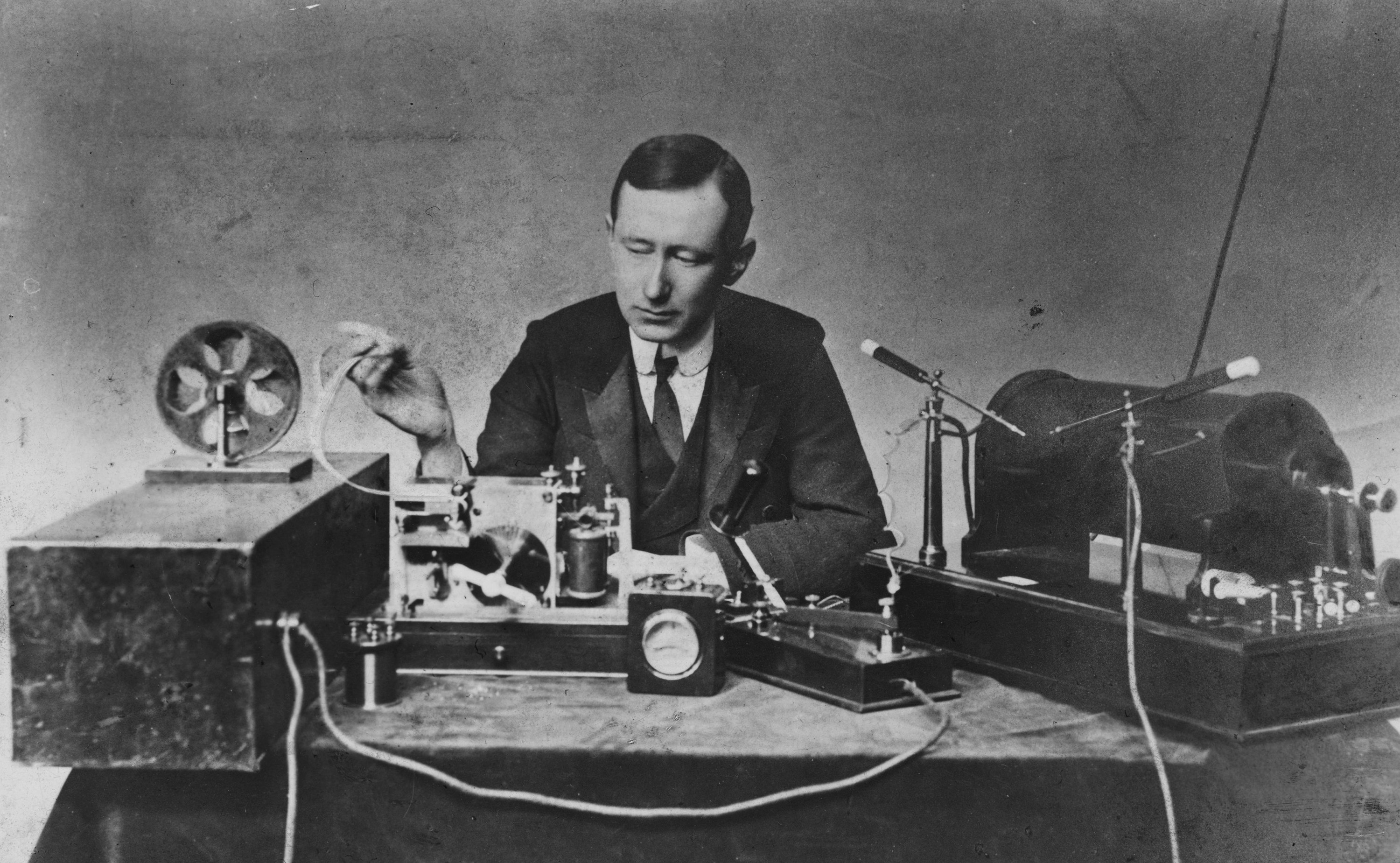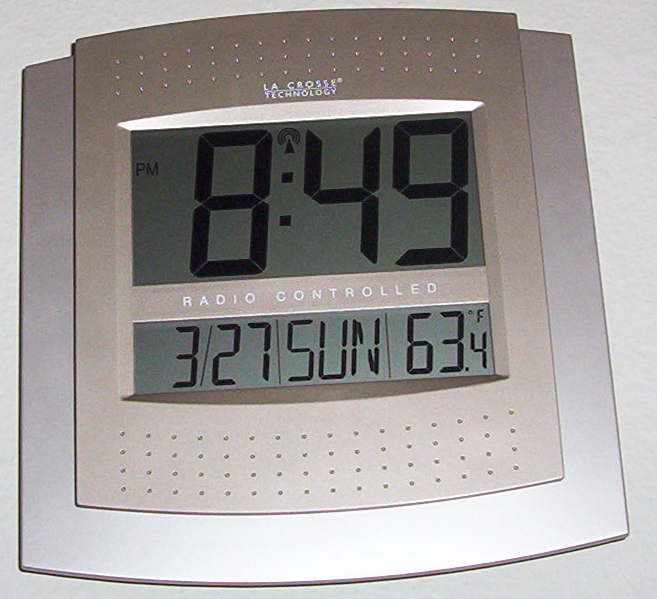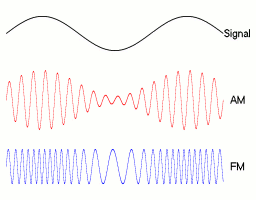|
Ground Wave
Ground waves are radio waves propagating parallel to and adjacent to the surface of the Earth, following the curvature of the Earth. This radiation is known as Norton surface wave, or more properly Norton ground wave, because ground waves in radio propagation are not confined to the surface. Overview Lower frequency radio waves, below 3 MHz, travel efficiently as ground waves. In ITU nomenclature, this includes (in order): medium frequency (MF), low frequency (LF), very low frequency (VLF), ultra low frequency (ULF), super low frequency (SLF), extremely low frequency (ELF) waves. Ground propagation works because lower-frequency waves are more strongly diffracted around obstacles due to their long wavelengths, allowing them to follow the Earth's curvature. Ground waves propagate in vertical polarization, with their magnetic field horizontal and electric field (close to) vertical. Conductivity of the surface affects the propagation of ground waves, with more co ... [...More Info...] [...Related Items...] OR: [Wikipedia] [Google] [Baidu] |
Radio Waves
Radio waves are a type of electromagnetic radiation with the longest wavelengths in the electromagnetic spectrum, typically with frequencies of 300 gigahertz ( GHz) and below. At 300 GHz, the corresponding wavelength is 1 mm (shorter than a grain of rice); at 30 Hz the corresponding wavelength is (longer than the radius of the Earth). Like all electromagnetic waves, radio waves in a vacuum travel at the speed of light, and in the Earth's atmosphere at a close, but slightly lower speed. Radio waves are generated by charged particles undergoing acceleration, such as time-varying electric currents. Naturally occurring radio waves are emitted by lightning and astronomical objects, and are part of the blackbody radiation emitted by all warm objects. Radio waves are generated artificially by an electronic device called a transmitter, which is connected to an antenna which radiates the waves. They are received by another antenna connected to a radio receiv ... [...More Info...] [...Related Items...] OR: [Wikipedia] [Google] [Baidu] |
Longwave
In radio, longwave, long wave or long-wave, and commonly abbreviated LW, refers to parts of the radio spectrum with wavelengths longer than what was originally called the medium-wave broadcasting band. The term is historic, dating from the early 20th century, when the radio spectrum was considered to consist of longwave (LW), medium wave, medium-wave (MW), and short wave radio, short-wave (SW) radio bands. Most modern radio systems and devices use wavelengths which would then have been considered 'ultra-short'. In contemporary usage, the term ''longwave'' is not defined precisely, and its intended meaning varies. It may be used for radio wavelengths longer than 1,000 m i.e. frequencies up to 300 kilohertz (kHz), including the International Telecommunication Union, International Telecommunication Union's (ITU's) low frequency (LF, 30–300 kHz) and very low frequency (VLF, 3–30 kHz) bands. Sometimes the upper limit is taken to be higher than 300 kHz, ... [...More Info...] [...Related Items...] OR: [Wikipedia] [Google] [Baidu] |
Ionosphere
The ionosphere () is the ionized part of the upper atmosphere of Earth, from about to above sea level, a region that includes the thermosphere and parts of the mesosphere and exosphere. The ionosphere is ionized by solar radiation. It plays an important role in atmospheric electricity and forms the inner edge of the magnetosphere. It has practical importance because, among other functions, it influences radio propagation to distant places on Earth. History of discovery As early as 1839, the German mathematician and physicist Carl Friedrich Gauss postulated that an electrically conducting region of the atmosphere could account for observed variations of Earth's magnetic field. Sixty years later, Guglielmo Marconi received the first trans-Atlantic radio signal on December 12, 1901, in St. John's, Newfoundland (now in Canada) using a kite-supported antenna for reception. The transmitting station in Poldhu, Cornwall, used a spark-gap transmitter to produce a signal with a f ... [...More Info...] [...Related Items...] OR: [Wikipedia] [Google] [Baidu] |
D Layer
The ionosphere () is the ionized part of the upper atmosphere of Earth, from about to above sea level, a region that includes the thermosphere and parts of the mesosphere and exosphere. The ionosphere is ionized by solar radiation. It plays an important role in atmospheric electricity and forms the inner edge of the magnetosphere. It has practical importance because, among other functions, it influences radio propagation to distant places on Earth. History of discovery As early as 1839, the German mathematician and physicist Carl Friedrich Gauss postulated that an electrically conducting region of the atmosphere could account for observed variations of Earth's magnetic field. Sixty years later, Guglielmo Marconi received the first trans-Atlantic radio signal on December 12, 1901, in St. John's, Newfoundland (now in Canada) using a kite-supported antenna for reception. The transmitting station in Poldhu, Cornwall, used a spark-gap transmitter to produce a signal with a frequenc ... [...More Info...] [...Related Items...] OR: [Wikipedia] [Google] [Baidu] |
Shortwave
Shortwave radio is radio transmission using shortwave (SW) radio frequencies. There is no official definition of the band, but the range always includes all of the high frequency band (HF), which extends from 3 to 30 MHz (100 to 10 metres); above the medium frequency band (MF), to the bottom of the VHF band. Radio waves in the shortwave band can be reflected or refracted from a layer of electrically charged atoms in the atmosphere called the ionosphere. Therefore, short waves directed at an angle into the sky can be reflected back to Earth at great distances, beyond the horizon. This is called skywave or "skip" propagation. Thus shortwave radio can be used for communication over very long distances, in contrast to radio waves of higher frequency, which travel in straight lines (line-of-sight propagation) and are limited by the visual horizon, about 64 km (40 miles). Shortwave broadcasts of radio programs played an important role in the early days of rad ... [...More Info...] [...Related Items...] OR: [Wikipedia] [Google] [Baidu] |
Short Wave
Shortwave radio is radio transmission using shortwave (SW) radio frequencies. There is no official definition of the band, but the range always includes all of the High frequency, high frequency band (HF), which extends from 3 to 30 MHz (100 to 10 metres); above the Medium frequency, medium frequency band (MF), to the bottom of the Very high frequency, VHF band. Radio waves in the shortwave band can be reflected or refracted from a layer of electrically charged atoms in the atmosphere called the ionosphere. Therefore, short waves directed at an angle into the sky can be reflected back to Earth at great distances, beyond the horizon. This is called skywave or "skip" radio propagation, propagation. Thus shortwave radio can be used for communication over very long distances, in contrast to radio waves of higher frequency, which travel in straight lines (line-of-sight propagation) and are limited by the visual horizon, about 64 km (40 miles). Shortwave broadcasts ... [...More Info...] [...Related Items...] OR: [Wikipedia] [Google] [Baidu] |
Medium Wave
Medium wave (MW) is the part of the medium frequency (MF) radio band used mainly for AM radio broadcasting. The spectrum provides about 120 channels with more limited sound quality than FM stations on the FM broadcast band. During the daytime, reception is usually limited to more local stations, though this is dependent on the signal conditions and quality of radio receiver used. Improved signal propagation at night allows the reception of much longer distance signals (within a range of about 2,000 km or 1,200 miles). This can cause increased interference because on most channels multiple transmitters operate simultaneously worldwide. In addition, amplitude modulation (AM) is often more prone to interference by various electronic devices, especially power supplies and computers. Strong transmitters cover larger areas than on the FM broadcast band but require more energy and longer antennas. Digital modes are possible but have not reached momentum yet. MW was the main radi ... [...More Info...] [...Related Items...] OR: [Wikipedia] [Google] [Baidu] |
Long Wave
In radio, longwave, long wave or long-wave, and commonly abbreviated LW, refers to parts of the radio spectrum with wavelengths longer than what was originally called the medium-wave broadcasting band. The term is historic, dating from the early 20th century, when the radio spectrum was considered to consist of longwave (LW), medium-wave (MW), and short-wave (SW) radio bands. Most modern radio systems and devices use wavelengths which would then have been considered 'ultra-short'. In contemporary usage, the term ''longwave'' is not defined precisely, and its intended meaning varies. It may be used for radio wavelengths longer than 1,000 m i.e. frequencies up to 300 kilohertz (kHz), including the International Telecommunication Union's (ITU's) low frequency (LF, 30–300 kHz) and very low frequency (VLF, 3–30 kHz) bands. Sometimes the upper limit is taken to be higher than 300 kHz, but not above the start of the medium wave broadcast band at 520& ... [...More Info...] [...Related Items...] OR: [Wikipedia] [Google] [Baidu] |
Invention Of Radio
The invention of radio communication was preceded by many decades of establishing theoretical underpinnings, discovery and experimental investigation of radio waves, and engineering and technical developments related to their transmission and detection. These developments allowed Guglielmo Marconi to turn radio waves into a wireless communication system. The idea that the wires needed for electrical telegraph could be eliminated, creating a wireless telegraph, had been around for a while before the establishment of radio-based communication. Inventors attempted to build systems based on Electrical conductor, electric conduction, electromagnetic induction, or on other theoretical ideas. Several inventors/experimenters came across the phenomenon of radio waves before its existence was proven; it was written off as electromagnetic induction at the time. The discovery of electromagnetic waves, including radio waves, by Heinrich Rudolf Hertz in the 1880s came after theoretical devel ... [...More Info...] [...Related Items...] OR: [Wikipedia] [Google] [Baidu] |
Over-the-horizon Radar
Over-the-horizon radar (OTH), sometimes called beyond the horizon radar (BTH), is a type of radar system with the ability to detect targets at very long ranges, typically hundreds to thousands of kilometres, beyond the radar horizon, which is the distance limit for ordinary radar. Several OTH radar systems were deployed starting in the 1950s and 1960s as part of early warning radar systems, but these have generally been replaced by airborne early warning systems. OTH radars have recently been making a comeback, as the need for accurate long-range tracking becomes less important with the ending of the Cold War, and less-expensive ground-based radars are once again being considered for roles such as maritime reconnaissance and drug enforcement. Technology The frequency of radio waves used by most radars, in the form of microwaves, travel in straight lines. This generally limits the detection range of radar systems to objects on their horizon (generally referred to as "line of ... [...More Info...] [...Related Items...] OR: [Wikipedia] [Google] [Baidu] |
Low Frequency
Low frequency (LF) is the ITU designation for radio frequencies (RF) in the range of 30–300 kHz. Since its wavelengths range from 10–1 km, respectively, it is also known as the kilometre band or kilometre wave. LF radio waves exhibit low signal attenuation, making them suitable for long-distance communications. In Europe and areas of Northern Africa and Asia, part of the LF spectrum is used for AM broadcasting as the "longwave" band. In the western hemisphere, its main use is for aircraft beacon, navigation (LORAN), information, and weather systems. A number of time signal broadcasts also use this band. Propagation Because of their long wavelength, low frequency radio waves can diffract over obstacles like mountain ranges and travel beyond the horizon, following the contour of the Earth. This mode of propagation, called ''ground wave'', is the main mode in the LF band. Ground waves must be vertically polarized (the electric field is vertical while the mag ... [...More Info...] [...Related Items...] OR: [Wikipedia] [Google] [Baidu] |
AM Broadcasting
AM broadcasting is radio broadcasting using amplitude modulation (AM) transmissions. It was the first method developed for making audio radio transmissions, and is still used worldwide, primarily for medium wave (also known as "AM band") transmissions, but also on the longwave and shortwave radio bands. The earliest experimental AM transmissions began in the early 1900s. However, widespread AM broadcasting was not established until the 1920s, following the development of vacuum tube receivers and transmitters. AM radio remained the dominant method of broadcasting for the next 30 years, a period called the " Golden Age of Radio", until television broadcasting became widespread in the 1950s and received most of the programming previously carried by radio. Subsequently, AM radio's audiences have also greatly shrunk due to competition from FM (frequency modulation) radio, Digital Audio Broadcasting (DAB), satellite radio, HD (digital) radio, Internet radio, music streaming se ... [...More Info...] [...Related Items...] OR: [Wikipedia] [Google] [Baidu] |





